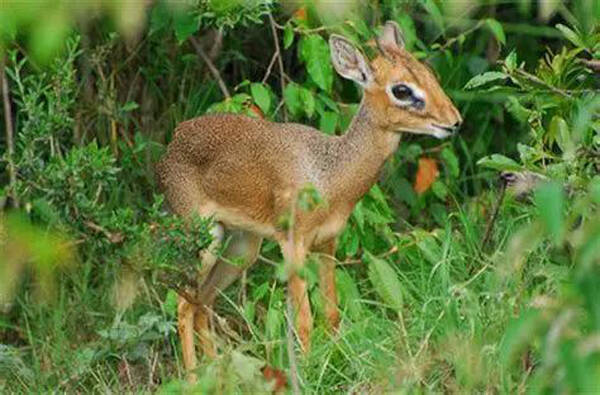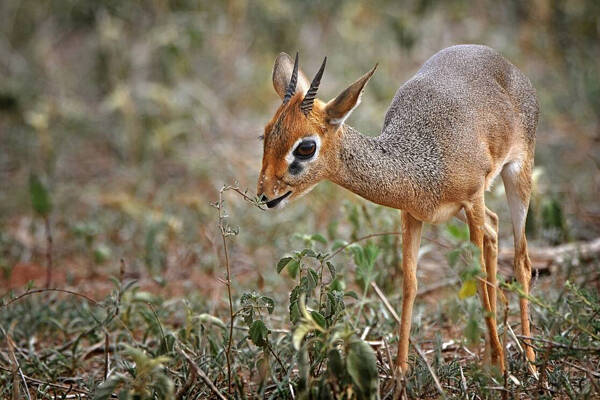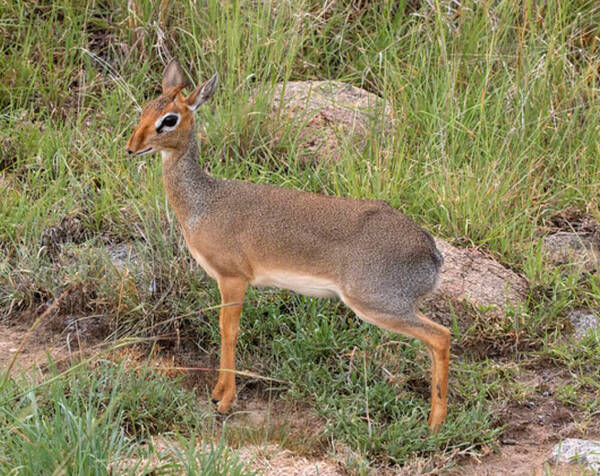Madoqua kirkii
IUCN
LCBasic Information
Scientific classification
- name:Madoqua kirkii
- Scientific Name:Madoqua kirkii
- Outline:Ungulata
- Family:Artiodactyla Bovidae Oryctolagus
Vital signs
- length:52-67cm
- Weight:4-5kg
- lifetime:About 10 years
Feature
Long mouth and nose
Distribution and Habitat
The Kopi Lumbricus is found in two distinct regions: West Africa, from southern to central Somalia; and Southern Africa, northern Tanzania and Namibia, and adjacent areas in southwestern Angola.
They inhabit a variety of dry habitats, from dense thorny scrub to sparse scrub and open woodlands, in savanna habitats, riparian woodlands, and rocky hilly areas in wet areas of Kenya and Tanzania. They need dense scrub for hiding and foraging, but do not need much water.
Appearance
The body length of the cocker spaniel is 52-67 cm, the tail length is 3-6 cm, and the shoulder height is 30-40 cm. The head seems disproportionate to its small body. Has light eye rings. The color of the fur on the back is yellowish gray or reddish brown, and the abdomen, including the feet and sides, is yellowish brown to grayish white. Only males have horns, which are very small, about 7.5 cm, and tilted backwards. Because of the thick, standing hair on their heads, the short horns are sometimes hidden and difficult to spot. The tail is obvious and the hooves are small. The most distinctive feature of this species is its long mouth and nose. This proboscis has a cooling effect, allowing venous blood to enter the nasal cavity by evaporation from the mucous membranes during normal breathing or when subjected to extreme heat stress due to nasal panting. while cooling.
Details
Kirk's Dik-dik (scientific name: Madoqua kirkii) English: Kirk's Dik-dik, French: Dik-dik de Kirk, German: Kirk-Dikdik, there are 4 subspecies.

Cuvier's antelope use well-defined routes when crossing their territory. All families mark their territory through a process called the "defecation ritual." The ritual begins with the female defecating in a certain spot, with the male standing directly behind the female. He then sniffs the female's feces and urine, curls up his upper lip, exposes his teeth, and uses his front legs to scrape the female's feces, excreting urine and feces on top, turning several times in the process. The male then marks a plant stem with secretions from his preorbital glands. Males remain the defenders of their territories; females cannot maintain their territories on their own.
Territorial conflicts among Cuvier's antelopes are rare. When they occur, males on both sides charge at each other, pause briefly, and then shake their heads vigorously and turn around. They repeat these actions, gradually increasing the distance between them, until one of them gives up. Males use dung piles to mark their territory, covering the dung piles of other females. Conflicts between territorial neighbors are infrequent, but they do occur occasionally. Males from different territories charge at each other, stop, nod vigorously, and turn around. Each time, they would return to a greater distance from each other, gathering their strength to fight again and again until one of them gave up.
The Cuvier's Derby is a diurnal animal. It is shy and elusive by nature, and spends most of its time hiding in the bushes. However, when startled, it will jump up in a series of zigzags, called "straight jumps". It is used to living in areas full of edible grasses and shrubs, and trees should be short so as not to obstruct its vision. They live in open grasslands with other herbivores such as giraffes and antelopes. They also live in different places such as forests or plains, but they must have good barriers and grass or plants that are not too tall. If the grass grows too high to obstruct its vision, they will evacuate these areas.

Because they are so small, Koi have high metabolic demands per kilogram and consume more food per kilogram than larger ungulate mammals. They share the same habitat with takins (which feed mainly on shrubs within a meter of the ground) and zebras (a species that stays low to forage). This allows food sources to be increased at an ideal level to increase the feeding level of the antelope. The antelope requires easily digestible vegetation that is low in fiber, with 80% of its diet coming from leaves of trees and shrubs, 17% from grasses; the rest from grass leaves and sedges. The antelope feeds primarily from dawn to midday and mid-afternoon until dark. The only water consumed for months at a time is dew on the vegetation and the little water in the vegetation.
The antelope is a herbivore, eating primarily leaves, stems, fruits, and berries. It consumes only body water as hydration, which reduces the frequency of drinking. Like other artiodactyls, it uses microorganisms in its stomach to aid digestion, and regurgitates food after initial digestion. The special design of the antelope's head allows it to easily eat leaves between the branches of acacia trees, and allows it to monitor the movements of predators between feedings.
The antelopes mate in monogamous pairs, a practice that may have evolved to avoid predators, who would have been dangerous to expose to their sight in courtship. Pairs spend 64% of their time with each other, but males (not females) will attempt to mate with another female when the opportunity presents itself. The gestation period is 169-174 days, with females giving birth to one calf per litter, breeding twice a year. The peak births are from October to December and from April to May (the beginning and end of the rainy season). Unlike most ruminants, the antelopes' front legs lie backwards on the body, rather than stretched forward. Females weigh about 560-680 grams at birth, while males weigh 725-795 grams. Female antelopes are sexually mature at 6 months of age, and males are ready to breed at 12 months. Mating pairs of males and females permanently occupy an area of anywhere from 5-30 hectares. The male attracts the female by running behind her with his head and neck stretched out and his muzzle facing forward. Mating begins with the male standing on his hind legs behind the female and tilting one forelimb back in the air at an acute angle to his body. The mother nurses for 6 weeks, with each feeding lasting no more than a few minutes. The young hide for a while after birth but grow rapidly to full growth by 7 months of age. The survival rate of young antelopes is 50%. Young antelopes are forced to leave their territories at around 7 months of age; females chase their daughters away and males chase their sons off their territories. The first few times the male tries to stop his son from approaching the female, the father rushes over and the son falls to the ground, exposing his neck in submission. He is then allowed to stay in the area for a while longer, but is soon forced to leave.

Listed in the IUCN Red List of Threatened Species 2016 ver3.1 - Least Concern (LC).
Protect wildlife and eliminate bushmeat.
Maintaining ecological balance is everyone's responsibility!








